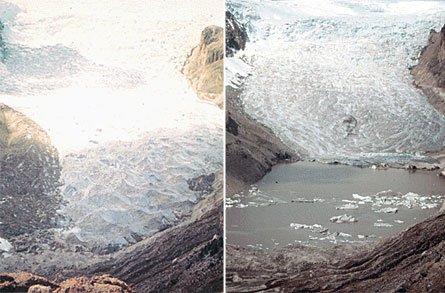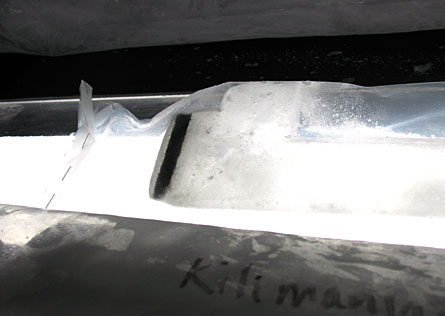Science loses out when ice caps melt
Tropical glaciers are vanishing at an especially rapid pace—and taking valuable climate records with them.
Share this:
- Share via email (Opens in new window) Email
- Click to share on Facebook (Opens in new window) Facebook
- Click to share on X (Opens in new window) X
- Click to share on Pinterest (Opens in new window) Pinterest
- Click to share on Reddit (Opens in new window) Reddit
- Share to Google Classroom (Opens in new window) Google Classroom
- Click to print (Opens in new window) Print
By Susan Gaidos
 |
|
At left is Peru’s Qori Kalis glacier in 1978, when it was still healthy. At right is the much-reduced glacier in 2000. A lake of meltwater now occupies what 22 years earlier had been a deep field of flowing ice.
|
| Ohio State Univ. |
It’s hard to imagine a mountain range without snow-covered peaks. But that may soon be the case in countries in or near the tropics. Studies show that the ice that sits atop the world’s highest mountains is vanishing at an alarming rate. That trend threatens to leave the summits bare.
The rapid melting of these glacial caps is visible evidence that Earth is getting warmer, scientists say. Most of Earth’s glaciers have been shrinking for decades. The cause: Earth’s climate has been warming (both from natural causes and human activities).
Although Earth’s atmosphere is warming nearly everywhere, the greatest warming has been taking place at high elevations and in tropical portions of the world, says Lonnie Thompson. He’s a glaciologist — or scientist who studies glaciers — at Ohio State University in Columbus. In very high tropical glaciers, temperatures have been warming at three times the rate of increases seen at ground level.
Most mountain peaks are high enough that the snow falling onto them should stay frozen year-round. That’s because air at high altitudes is less dense and holds less heat. As the snow piles higher and higher, the bottom layers become compressed into ice, forming a glacier — a slowly moving river of ice.
For scientists, the real beauty of glaciers is that there’s so little melting. A year’s worth of snow can be crunched down to form an annual layer that normally survives hundreds — if not thousands — of years. Essentially the deeper you probe down into a glacier’s ice, the farther back in time you get.
 |
|
The black line in this glacial core collected atop Mt. Kilimanjaro corresponds to a prolonged deposition of dust 4,200 years ago that likely represents 300 years of drought.
|
| J. Raloff |
Those annual ice layers — “they’re like tree rings,” says Thompson. Over his career, he has traveled the world, measuring the shriveling snowcaps atop some of the world’s highest mountains. His studies show that the huge Quelccaya (kal-KI-yah) Ice Cap, a tropical glacier that stretches across the Peruvian Andes, is shriveling by about 18 inches a day.
“You can almost sit there and watch it lose ground,” Thompson says.
Another glacier — one that sits atop Mount Kilimanjaro in Tanzania — has been melting steadily for nearly 100 years. Over that time it has lost 84 percent of its ice.
Like tree rings, the layers found in glaciers also have an important story to tell. That’s because snowpacks absorb chemicals, pollen and dust from the atmosphere. In this way, the ice masses that sit atop mountains have been collecting data about Earth’s climate for centuries or more.
But as these ice caps rapidly disappear, they are taking their historical records with them. Losing data of this type means losing some important history about the long-lasting impacts of natural climate, Thompson says.
He and his co-workers have been busy drilling into snow-covered mountain tops to obtain ice cores before the melting causes these records to vanish. To date that ice has preserved some 7,000 ice cores. One ice core from Mount Kilimanjaro contains climate data going back 11,700 years. That’s longer than any documented history.
These ice cores can tell scientists about the role that climate played in the rise and fall of cultures throughout history. The core sampled atop Mt. Kilimanjaro, for example, shows a three-millimeter-thick band of black dust. It initially settled onto the snowpack some 4,200 years ago. This date corresponds to archaeological records showing a 300-year drought in Egypt.
Thompson and others believe that the history preserved in the ice cores may also help foretell Earth’s future climate. For example, data from the glaciers offers clues as to how past temperature changes affected El Niños, the atmospheric-oceanic disturbances that hit the central West Pacific every few years. Studies of these data may help scientists predict how droughts and floods caused by an El Niño might grow as the world warms in decades to come.
Going Deeper:
Polar Ice Feels the Heat
http://www.sciencenewsforkids.org/articles/20080423/Feature1.asp
Earth’s Poles in Peril
http://www.sciencenewsforkids.org/articles/20070530/Feature1.asp







